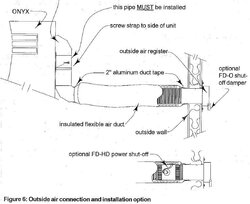Hi Folks,
Seems on browsing the threads that this is a common issue in cold climates. I am building a cottage in Eastern Ontario and have installed a Napolean NZ6000. After closing in the framing with cement board, we noticed some sweating on the exterior of the stove and some drips on the ground. On removing the cement board we noted that OAK flex pipe was frosted up at the point of connection to the stove as well. Now that cement board is off, vent pipe is no longer frozen but stove is still sweating.
On reviewing the threads, I see that the main advice is to insulate the intake vent pipe. To my mind this will still result in condensation unless the insulation results in a true vapor barrier along the length of the pipe. Any comments/experience on that?
I can actually feel air draw into the outside vents when I stick my hand in them (slight, but its there). I assume this is due to convection and the vent pipe eventually acts like a syphon for cold air. We are properly insulated, vapour barriered and sealed in the stove enclosure itself.
The only other things I can think of that might help:
1. Ensure at least 3-4 loops and a large upward rise in the intake pipe before heading down to the stove inlet (already have the large rise, but no loops) to restrict the syphon effect and allow air to warm up in the pipe.
2. Make sure that the stove enclosure is well vented to the house so that warm air can get in (stove enclosure and vent pipe is in the warm zone).
3. Install a damper in the intake vents that can be closed when not burning the stove. This may be the most effective solution.
Any comments or experiences to share? I want to get this bullet proof before I close it up permanently.
Thanks...
Seems on browsing the threads that this is a common issue in cold climates. I am building a cottage in Eastern Ontario and have installed a Napolean NZ6000. After closing in the framing with cement board, we noticed some sweating on the exterior of the stove and some drips on the ground. On removing the cement board we noted that OAK flex pipe was frosted up at the point of connection to the stove as well. Now that cement board is off, vent pipe is no longer frozen but stove is still sweating.
On reviewing the threads, I see that the main advice is to insulate the intake vent pipe. To my mind this will still result in condensation unless the insulation results in a true vapor barrier along the length of the pipe. Any comments/experience on that?
I can actually feel air draw into the outside vents when I stick my hand in them (slight, but its there). I assume this is due to convection and the vent pipe eventually acts like a syphon for cold air. We are properly insulated, vapour barriered and sealed in the stove enclosure itself.
The only other things I can think of that might help:
1. Ensure at least 3-4 loops and a large upward rise in the intake pipe before heading down to the stove inlet (already have the large rise, but no loops) to restrict the syphon effect and allow air to warm up in the pipe.
2. Make sure that the stove enclosure is well vented to the house so that warm air can get in (stove enclosure and vent pipe is in the warm zone).
3. Install a damper in the intake vents that can be closed when not burning the stove. This may be the most effective solution.
Any comments or experiences to share? I want to get this bullet proof before I close it up permanently.
Thanks...


